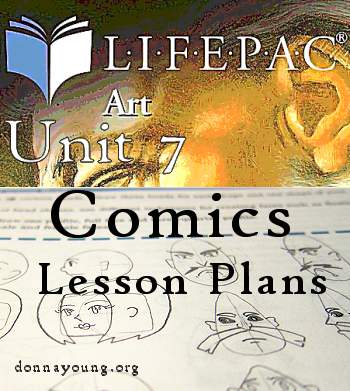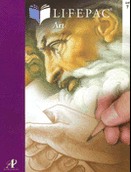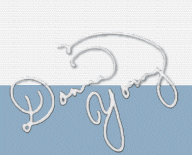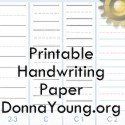AOP Art Electives, Unit 7 Comics
Written: Nov 21 2010, by Donna YoungThis article is a home school teacher's (Donna Young) perspective on the curriculum Unit 7 Comics. Supply lists, scheduling suggestions, and time estimates are included.

About the minimums and maximums in the supply lists: In the supply lists, I have included minimums and maximums for the items and I hope this does not confuse you. A minimum item is a perfectly acceptable item for a student. The items in the maximum range are closer to what a professional would use.
Unit 7 Comics is part of a 10-book art curriculum set AOP LifePacs Art Electives, but it is also sold separately. The 10-book set is explained at About AOP LifePac Electives Art.
Unit VII: Comics
at CBD
 Art Lifepac 7: Comics
Art Lifepac 7: Comics
By Alpha Omega Publications
1. History
2. The Cartoon Figure
3. Layout and Design
ISBN: 0740301691
"Lifepac Art Unit 7 covers comics, including how to draw parts of the cartoon figure, layout and design of the panel and camera angles, composition, backgrounds, text and more. 35 pages with glossary and evaluation, paperback. For Grades 7th-12th"
Time estimate: This class will take around 25 days or 5 weeks if the student does not do any extra work. This time estimate allows 7-9 days for activity 3.1.
Planning Guide for AOP Art Electives, Unit 7 Comics
Course Materials
Books: From AOP Electives Art: Teachers Guide and Unit 7 Comics
Other: Save newspaper comics and/or bookmark some online comics for activities 2.1 [pages 10], 2.3 [page 19], and 2.6 [page 20]
Magazines and clothing catalogs for activity 2.4 [page 20]
Field Trips: Activity 2.5 [page 20]: Go to a place where people assemble and can be unobtrusively observed and sketched.
Supplies Paper, pen, pencil, erasers, ruler, drawing surface
About the Supplies
Minimums and Maximums- Paper: For this class, use paper that accepts pen & ink.
- Paper Minimum: A tape-bound pad of 70 lb. acid free paper
- Paper Maximum: Bristol board
- Paper Sizes: 8.5x11, 9x12, 11x14, & larger The first size is printer paper size. You do not have to get one pad of each size. These are simply the sizes that you could get and your student will need at least one size. The major activity, 3.1 on page 29, calls for a large piece of paper because the final project will be reduced electronically by 50%. See activity 3.1 on page 29 and page 32 above the "Instructor Check" for more details
- Pen
- Pen Minimum: Black rolling ball fine point ink pen
- Pen Medium: Something like a pack of black Faber-Castell PITT artist pens with various tip sizes
- Pen Maximum: Sable brush and jar of black India ink & nib pens & technical ink pen
- Pencils: A hard pencil, one labeled with #H such as 2H. The pencil can be a mechanical pencil or a wooden pencil.
- Erasers: A pink eraser block and a gum eraser
- Ruler
- Ruler Minimum: 12 inch ruler
- Ruler Maximum: T-square & Triangle assuming that the student will have a suitable drawing table
- Drawing Surface
- Drawing Surface Minimum: A drawing pad, or a table with a flat, hard, smooth item that is placed under the drawing paper.
- Drawing Surface Maximum: A draftsman table that has adjustable height and adjustable table top angle
The absolute minimum supplies for this class: 2H pencil, eraser, 12-inch ruler, a drawing pad that can handle ink, and a rolling ball black ink pen.
*I listed the maximums so that you could see the range of quality within the supplies and so that you could match the supplies to the students level of interest. In other words, a student who draws comics already and has for years drawn comics might prefer the maximum supplies. A student who is new to drawing cartoons or has little interest can use the minimum supplies.
Pages Used from The AOP Electives Art Teacher's Guide
Listed below are the pages that you will look at in Teachers Guide:
Activities & Supplementary Information pages 47-49
Alternate Test: pages 68-69, Key page 82
Self Test Keys: page 96
Unit Test Key: page 108
Suggested Books for the Student of Comics
We have both of thes books- Making Comics by Scott McCloud
- If your older student enjoyed this class, look into Drawing Words and Writing Pictures by Jessica Abel and Matt Madden. "Drawing Words and Writing Pictures is a course on comic creation – for college classes or for independent study – that centers on storytelling and concludes with making a finished comic."
Guide - Scheduling Thoughts - AOP Art Electives Unit 7 Comics
First ask yourself: "How much time can we devote to this Unit?" Below are three If's.
-If you are completing the entire 10 units of AOP Electives Art in this school year, then time is limited to 3.6 weeks or 18 days if you are on a 180 day Monday through Friday school year schedule.
Heads-up- My rough estimate for the time that this class will need is 5-weeks minimum.
-If you are setting aside one quarter for this unit, then that is how much time you have. A typical quarter is 9 weeks.
-If this is a "finish when we finish" course, then there you go, your schedule will be open ended.
A Fact About the Book: There are 35 printed pages in the unit, but we do not go by the pages divided by the days to make a schedule for this unit. We have to look at the pages to determine how much the student might do each day.
Drawing Notebook Question: Will your student maintain a notebook for this course? If so, set that up.
Contents Of Unit 7 & Donna's Scheduling Thoughts
Introductory Class
Go over the glossary [page 34] and go over the objectives on page one. Depending on remaining class time - have the student either read the entire unit or spend the rest of the class time reading/scanning the book.
I. History
1 class - Very short, including Self Test 1
II. The Cartoon Figure
11 Classes or more
A. Head Pages 5-11, 3 or more classes - 2 official activities
Cliches are defined at the beginning of Head with glass cliche examples. Head covers shapes, angles, expressions, and profiles.
Possible way to cover pages 5-11
1. Read through page 5-11, if using a notebook, make notes.
2. Complete activity 2.1
3. Complete activity 2.2.
- (4. Unofficial activity)-
If you are not in a hurry, the student should refer to page 9 and practice drawing facial expressions. If you own the book mentioned below, use it at this time -(optional).
Outside Book- Optional- If the student has the book, Making Comics by Scott McCloud, use that to explore drawing facial expressions. The student could start on page 62, but the bulk of facial expression starts on page 80.
B. Body Pages 12-15, 1 class - reading, make notes and sketches in notebook
Body has only a few pages and no activities (yet), but you could assign drawing activities so that the student can practice what is mentioned on the pages. At the very least, the student could start a new page in a drawing notebook for each item mentioned on the pages and draw examples for each item.
C.Foreshortening Pages 15-17, 1 class - reading, make notes and sketches in notebook
A short bit that is about a common drawing obstacle, foreshortening. Drawing foreshortened items should, and needs, to be practiced by the art student, if not now, then later.
D. Clothing Pages 17-19, 1 class - reading, make notes and sketches in notebook
Self Test 2 Page 21, 1 class
Activities 2.3 - 2.7, 5 classes (or days)
At the end of section II are five activities Activity 2.3, Activity 2.4, Activity 2.5, Activity 2.6, and Activity 2.7. Your call on this suggestion -Consider allowing one class per example - this would mean 5 classes for Activity 2.7 instead of 1.
III. Layout and Design
Undetermined amount of classes, but let us estimate 4 days of class time and 7-10 days for Activity 3.1.
Parts "A" through "E" are short - only 6 pages long, The Panel "A" begins on page 22 and Text "E" ends on page 28. The student can read the entire section in one sitting, then move on to Activity 3.1 Comics Production, see more below
a. The Panel, 1/5th class
b. Camera Angles, 1/5th class
c. Composition, 1/5th class
d. Backgrounds, 1/5th class
e. Text , 1/5th class
Please Note: If the student is making notes and drawings in a class notebook, parts A-E could take more than one class.
Activity 3.1 begins on page 28 and is explained at length. The student should read pages 28-32 to get an idea of how the project should flow what to do first, then second, and so forth. You might notice right away that there is a tiny problem with step I The Story B. is not covered in the book, however; that part should be easy enough to figure out.
Self Test 3 1 or 2 classes - Will student have a day to study for test or will the student take this test after completing Activity 3.1?
Unit Test. The student should study the day before and the test should be closed book.
Time estimate for this class: 25 days or 5 weeks minimum This is without extra practice work that I suggested.
Note: In the Teachers Guide Appendix, starting on page 112 is a section on Evaluating the Students Work.
A Basic Lesson Plan
Despite this article being a "guide," I will provide a basic lesson plan; it is linked below. The lesson plan is a simple checklist and it does not include any of my suggestions for additional work. I have to say though that I want you to read the guide that I wrote above starting here.
Checklist to glue inside the students workbook
 Checklist for AOP Art Unit 7 DOC
Checklist for AOP Art Unit 7 DOC
 Checklist for AOP Art Unit 7 DOCX
Checklist for AOP Art Unit 7 DOCX
For V Planner - after pasting into S Sheet, Column B, select "Match Destination Formatting" if pasting has caused the background color to change.
 Checklist for AOP Art Unit 7 TXT - Paste in V Planner - S Sheet, Column B
Checklist for AOP Art Unit 7 TXT - Paste in V Planner - S Sheet, Column B
See illustration below, click illustration to see full sized image.

The Student's Checklist Looks Something Like This
Edit the list as you see fit.
Although there are 24 boxes, this does not represent 24 days. Some items can be combined while more items in the list could take more than one class.
Trim
. . . . . . . . . . . . . . . . . . . . . . . . .
Your comments here
Page 34: Study the glossary, read/glance through the unit
I. History: read 1-4
Self Test 1
II. The Cartoon Figure Head: read pages 5-9
Page 10 Activity 2.1
Page 11 Activity 2.2
Body: read pages 12-15
Foreshortening: read pages 15-17
Clothing: read pages 17-19
Self Test 2 page 21
Activity 2.3
Activity 2.4
Activity 2.5
Activity 2.6
Activity 2.7
III. The Layout and Design Read pages 22-28
Activity 3.1 read pages 28-32, begin formulating ideas
Activity 3.1 parts Ia and Ib Begin by discussing parts Ia and Ib with the instructor, if the feedback is good start the work.
Activity 3.1 part II Show the preliminary sketches to your instructor for feedback.
Activity 3.1 part III Show your work daily or every other day to your instructor for feedback.
Activity 3.1 Reduce and color your strip
Self Test 3 page 33
Study for Unit test
Unit Test


 Skeleton - in Life Science
Skeleton - in Life Science Attendance H
Attendance H


